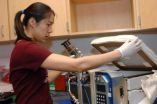(Press-News.org) A big part of coping with life is having a flexible reaction to the ups and downs. Now, a study which will be published in an upcoming issue of Psychological Science, a journal of the Association for Psychological Science, finds that people choose to respond differently depending on how intense an emotion is. When confronted with high-intensity negative emotions, they tend to choose to turn their attention away, but with something lower-intensity, they tend to think it over and neutralize the feeling that way.
Emotions are useful—for example, fear tells your body to get ready to escape or fight in a dangerous situation. But emotions can also become problematic – for example, for people with depression who can't stop thinking about negative thoughts, says Gal Sheppes of Stanford University, who cowrote the study with Stanford colleagues Gaurav Suri and James J. Gross, and Susanne Scheibe of the University of Groningen. "Luckily, our emotions can be adjusted in various ways," he says.
Sheppes and his colleagues studied two main ways that people modulate their emotions; by distracting themselves or by reappraising the situation. For example, if you're in the waiting room at the dentist, you might distract yourself from the upcoming unpleasantness by reading about celebrity breakups – "Maybe that's why the magazines are there in the first place," Sheppes says – or you might talk yourself through it: "I say, ok, I have to undergo this root canal, but it will make my health better, and it will pass, and I've done worse things, and I can remind myself that I'm ok."
While many previous studies directly instructed people to employ different strategies and measured their consequences, the researchers wanted to know which regulation strategies people choose for themselves when confronted with negative situations of mild and strong intensity. In one experiment, participants chose how to regulate negative emotions induced by pictures that produce a low-intensity emotion and some that produce high-intensity emotion – a picture of a snake in the grass, for example, should give you low-intensity fear, while a picture of a snake attacking with an open mouth should be more intense. In another experiment, participants chose how to regulate their anxiety while anticipating unpredictable electric shocks, but they were told before each shock whether it would be of low intensity or more painful shock. Before the experiments, the participants were trained on the two strategies, distraction and reappraisal, and during the experiments, they talked about which strategy they were using at which time.
In both experiments, when the negative emotion was low-intensity, participants preferred to reappraise – think through it, telling themselves why it wasn't so bad. But when high-intensity emotions arose, they preferred to distract themselves.
It's helpful to understand which strategies healthy people choose to regulate their emotions in different contexts, Sheppes says, because it seems like people with depression and anxiety disorders might have those problems partially because it is hard for them to flexibly modulate their emotions to differing situational demands. "Maybe they need to learn when and when not to engage," he says.
###
For more information about this study, please contact: Gal Sheppes at sheppes@stanford.edu.
The APS journal Psychological Science is the highest ranked empirical journal in psychology. For a copy of the article "Emotion Regulation Choice" and access to other Psychological Science research findings, please contact Divya Menon at 202-293-9300 or dmenon@psychologicalscience.org.
Distract yourself or think it over? 2 ways to deal with negative emotions
2011-07-07
ELSE PRESS RELEASES FROM THIS DATE:
How hot did Earth get in the past? Team of scientists uncovers new information
2011-07-07
The question seems simple enough: What happens to the Earth's temperature when atmospheric carbon dioxide levels increase? The answer is elusive. However, clues are hidden in the fossil record. A new study by researchers from Syracuse and Yale universities provides a much clearer picture of the Earth's temperature approximately 50 million years ago when CO2 concentrations were higher than today. The results may shed light on what to expect in the future if CO2 levels keep rising.
The study, which for the first time compared multiple geochemical and temperature proxies ...
The impact of candidates' statements about climate change on electoral success
2011-07-07
Candidates gain votes by taking a "green" position on climate change -- endorsing the existence of warming, human causation, and the need for taking action to address it, according to a new study of U.S. adults.
Among citizens who are Democrats and Independents, a hypothetical U.S. Senate candidate gained votes by making a green statement on climate change and lost votes by making a not-green statement, compared to making no statement on climate. Among citizens who are Republicans, the candidate's vote share was unaffected by taking a green position or a not-green position, ...
Energy express focus issue: Optics in LEDs for lighting
2011-07-07
WASHINGTON, July 5 – Light-emitting diodes (LEDs) have been changing the way we see the world since the 1960s. Their usage in everyday life is pervasive and continues to increase thanks to the cutting-edge research being done in the field of optics. To highlight breakthroughs in LEDs, the editors of Energy Express, a bi-monthly supplement to Optics Express, the open-access journal of the Optical Society (OSA), today published a special Focus Issue on Optics in LEDs for Lighting. The issue is organized and edited by Guest Editors Jae-Hyun Ryou and Russell Dupuis of the Georgia ...
Researchers characterize biomechanics of ovarian cells according to phenotype at stages of cancer
2011-07-07
Using ovarian surface epithelial cells from mice, researchers from Virginia Tech have released findings from a study that they believe will help in cancer risk assessment, cancer diagnosis, and treatment efficiency in a technical journal: Nanomedicine http://www.nanomedjournal.com/article/S1549-9634%2811%2900184-5/abstract
By studying the viscoelastic properties of the ovarian cells of mice, they were able to identify differences between early stages of ovarian cancer and more advanced and aggressive phenotypes.
Their studies showed a mouse's ovarian cells are stiffer ...
National Zoo Welcomes Whooping Crane
2011-07-07
After an 88-year-long hiatus North America's tallest bird, the statuesque whooping crane (Grus americana), is once again on exhibit at the Bird House at the Smithsonian's National Zoological Park. An 11-year-old male whooping crane named Rocky left Homosassa Springs State Park in Florida and is now on exhibit in the nation's capital. Whooping cranes are one of only two crane species native to the United States. There are only eight other zoos in the U.S. which exhibit these birds.
"It is an honor for the National Zoo to once again exhibit this magnificent species," said ...
Twin study shows lifestyle, diet can significantly influence course of macular degeneration
2011-07-07
BOSTON -- Eating a diet high in vitamin D, as well as the nutrients betaine and methionine, might help reduce the risk of macular degeneration, according to new research conducted by Tufts Medical Center scientists. Their study of identical twins from the US World War II Twin Registry also found that the more a person smoked, the higher their risk of developing macular degeneration. The study, "Smoking, Dietary Betaine, Methionine, and Vitamin D in Monozygotic Twins with Discordant Macular Degeneration: Epigenetic Implications" published in the journal Ophthalmology on ...
Researchers engineer functioning small intestine in laboratory experiments
2011-07-07
LOS ANGELES (July 5, 2011) – Researchers at The Saban Research Institute of Children's Hospital Los Angeles have successfully created a tissue-engineered small intestine in mice that replicates the intestinal structures of natural intestine—a necessary first step toward someday applying this regenerative medicine technique to humans.
The study led by Tracy C. Grikscheit, MD —"A Multicellular Approach Forms a Significant Amount of Tissue-Engineered Small Intestine in the Mouse"— has been published in the July issue of Tissue Engineering Part A, a premier biomedical journal. ...
Final space shuttle to carry 5 CU-Boulder-built payloads
2011-07-07
The University of Colorado Boulder is involved with five different space science payloads ranging from antibody tests that may lead to new bone-loss treatments to an experiment to improve vaccine effectiveness for combating salmonella when Atlantis thunders skyward July 8 on the last of NASA's 135 space shuttle missions.
One experiment, sponsored by the global pharmaceutical companies Amgen and UCB, will test an antibody to sclerostin -- a protein that has a negative effect on bone formation, mass and strength -- on lab mice flying on the shuttle. Researchers on the project ...
Eggs may help prevent heart disease and cancer
2011-07-07
One of nature's most perfect foods may be even better for us than previously thought.
While eggs are well known to be an excellent source of proteins, lipids, vitamins and minerals, researchers at the University of Alberta recently discovered they also contain antioxidant properties, which helps in the prevention of cardiovascular disease and cancer.
Jianping Wu, Andreas Schieber and graduate students Chamila Nimalaratne and Daise Lopes-Lutz of the U of A Department of Agricultural Food and Nutritional Science examined egg yolks produced by hens fed typical diets of ...
Self-paced walking test useful for evaluating progress in lifestyle intervention programs
2011-07-07
HOUSTON- (July 5, 2011) - The self-paced walking test, known as the 400-meter walk test, is effective in measuring improved physical function in postmenopausal women who have lost weight through healthy physical activity and dietary changes, according to collaborative research conducted by The University of Texas Health Science Center at Houston (UTHealth) and The University of Pittsburgh.
"The 400-meter self-paced walk test is a simple, cost-efficient and effective test clinicians or researchers can use to evaluate progress in a weight loss or physical activity program," ...



